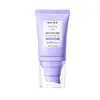What's inside
What's inside
 Key Ingredients
Key Ingredients

 Benefits
Benefits

 Concerns
Concerns

 Ingredients Side-by-side
Ingredients Side-by-side

Water
Skin ConditioningEthylhexyl Methoxycinnamate
UV AbsorberDiethylamino Hydroxybenzoyl Hexyl Benzoate
UV FilterButylene Glycol
HumectantMethyl Methacrylate Crosspolymer
Ethylhexyl Triazone
UV AbsorberBis-Ethylhexyloxyphenol Methoxyphenyl Triazine
Skin ConditioningGlycereth-26
HumectantEthylhexyl Palmitate
EmollientIsononyl Isononanoate
EmollientDimethicone
EmollientFomes Officinalis Extract
Skin ProtectingCetyl Alcohol
EmollientGlyceryl Stearate
Emollient1,2-Hexanediol
Skin ConditioningSorbitan Oleate
EmulsifyingSilica
AbrasiveHydroxyacetophenone
AntioxidantSodium Polyacrylate
AbsorbentPEG-75 Stearate
Acrylates/C10-30 Alkyl Acrylate Crosspolymer
Emulsion StabilisingPotassium Cetyl Phosphate
EmulsifyingTocopheryl Acetate
AntioxidantCeteth-20
CleansingSteareth-20
CleansingEctoin
Skin ConditioningAvena Sativa Kernel Extract
AbrasiveZinc PCA
HumectantSodium Hydroxide
BufferingXanthan Gum
EmulsifyingGentiana Scabra Root Extract
Skin ConditioningPhenoxyethanol
PreservativeDisodium EDTA
Tocopherol
AntioxidantPEG-40 Hydrogenated Castor Oil
EmulsifyingBHT
AntioxidantPentylene Glycol
Skin ConditioningWater, Ethylhexyl Methoxycinnamate, Diethylamino Hydroxybenzoyl Hexyl Benzoate, Butylene Glycol, Methyl Methacrylate Crosspolymer, Ethylhexyl Triazone, Bis-Ethylhexyloxyphenol Methoxyphenyl Triazine, Glycereth-26, Ethylhexyl Palmitate, Isononyl Isononanoate, Dimethicone, Fomes Officinalis Extract, Cetyl Alcohol, Glyceryl Stearate, 1,2-Hexanediol, Sorbitan Oleate, Silica, Hydroxyacetophenone, Sodium Polyacrylate, PEG-75 Stearate, Acrylates/C10-30 Alkyl Acrylate Crosspolymer, Potassium Cetyl Phosphate, Tocopheryl Acetate, Ceteth-20, Steareth-20, Ectoin, Avena Sativa Kernel Extract, Zinc PCA, Sodium Hydroxide, Xanthan Gum, Gentiana Scabra Root Extract, Phenoxyethanol, Disodium EDTA, Tocopherol, PEG-40 Hydrogenated Castor Oil, BHT, Pentylene Glycol
Water
Skin ConditioningZinc Oxide
Cosmetic ColorantCaprylyl Methicone
Skin ConditioningButyloctyl Salicylate
Skin ConditioningC9-12 Alkane
SolventDipropylene Glycol
HumectantPropylheptyl Caprylate
EmollientPolyglyceryl-3 Polydimethylsiloxyethyl Dimethicone
Skin ConditioningNiacinamide
SmoothingMethyl Trimethicone
Skin ConditioningDicaprylyl Ether
EmollientTitanium Dioxide
Cosmetic ColorantC12-15 Alkyl Benzoate
AntimicrobialMethyl Methacrylate Crosspolymer
Vinyl Dimethicone/Methicone Silsesquioxane Crosspolymer
Disteardimonium Hectorite
StabilisingMagnesium Sulfate
Triethoxycaprylylsilane
Sodium Potassium Aluminum Silicate
1,2-Hexanediol
Skin ConditioningPolyglyceryl-2 Dipolyhydroxystearate
Skin ConditioningLauryl Polyglyceryl-3 Polydimethylsiloxyethyl Dimethicone
Skin ConditioningDimethicone/Vinyl Dimethicone Crosspolymer
Skin ConditioningOctyldodecanol
EmollientSilica
AbrasivePolyhydroxystearic Acid
EmulsifyingDimethiconol
EmollientTrisiloxane
Skin ConditioningCI 77492
Cosmetic ColorantDibutyl Adipate
EmollientPoly C10-30 Alkyl Acrylate
Emulsion StabilisingCaprylyl Glycol
EmollientGlyceryl Caprylate
EmollientNeopentyl Glycol Diethylhexanoate
EmollientEthylhexylglycerin
Skin ConditioningAluminum Hydroxide
EmollientCI 77491
Cosmetic ColorantAdenosine
Skin ConditioningEchium Plantagineum Seed Oil
Skin ConditioningPolymethyl Methacrylate
Helianthus Annuus Seed Oil Unsaponifiables
EmollientCI 77499
Cosmetic ColorantTocopherol
AntioxidantCardiospermum Halicacabum Flower/Leaf/Vine Extract
Skin ConditioningCentella Asiatica Extract
CleansingSea Salt
AbrasiveSaccharomyces Ferment Filtrate
HumectantPropanediol
SolventGlycerin
HumectantAloe Barbadensis Leaf Extract
EmollientButylene Glycol
HumectantBombax Malabaricum Flower Extract
HumectantWater, Zinc Oxide, Caprylyl Methicone, Butyloctyl Salicylate, C9-12 Alkane, Dipropylene Glycol, Propylheptyl Caprylate, Polyglyceryl-3 Polydimethylsiloxyethyl Dimethicone, Niacinamide, Methyl Trimethicone, Dicaprylyl Ether, Titanium Dioxide, C12-15 Alkyl Benzoate, Methyl Methacrylate Crosspolymer, Vinyl Dimethicone/Methicone Silsesquioxane Crosspolymer, Disteardimonium Hectorite, Magnesium Sulfate, Triethoxycaprylylsilane, Sodium Potassium Aluminum Silicate, 1,2-Hexanediol, Polyglyceryl-2 Dipolyhydroxystearate, Lauryl Polyglyceryl-3 Polydimethylsiloxyethyl Dimethicone, Dimethicone/Vinyl Dimethicone Crosspolymer, Octyldodecanol, Silica, Polyhydroxystearic Acid, Dimethiconol, Trisiloxane, CI 77492, Dibutyl Adipate, Poly C10-30 Alkyl Acrylate, Caprylyl Glycol, Glyceryl Caprylate, Neopentyl Glycol Diethylhexanoate, Ethylhexylglycerin, Aluminum Hydroxide, CI 77491, Adenosine, Echium Plantagineum Seed Oil, Polymethyl Methacrylate, Helianthus Annuus Seed Oil Unsaponifiables, CI 77499, Tocopherol, Cardiospermum Halicacabum Flower/Leaf/Vine Extract, Centella Asiatica Extract, Sea Salt, Saccharomyces Ferment Filtrate, Propanediol, Glycerin, Aloe Barbadensis Leaf Extract, Butylene Glycol, Bombax Malabaricum Flower Extract
Ingredients Explained
These ingredients are found in both products.
Ingredients higher up in an ingredient list are typically present in a larger amount.
1,2-Hexanediol is a synthetic liquid and another multi-functional powerhouse.
It is a:
- Humectant, drawing moisture into the skin
- Emollient, helping to soften skin
- Solvent, dispersing and stabilizing formulas
- Preservative booster, enhancing the antimicrobial activity of other preservatives
Butylene Glycol (or BG) is used within cosmetic products for a few different reasons:
Overall, Butylene Glycol is a safe and well-rounded ingredient that works well with other ingredients.
Though this ingredient works well with most skin types, some people with sensitive skin may experience a reaction such as allergic rashes, closed comedones, or itchiness.
Learn more about Butylene GlycolThis ingredient comes as a powder made up of small, porous, microbeads. It is used to add a silky feel to products and also helps absorb oil.
Silica, also known as silicon dioxide, is a naturally occurring mineral. It is used as a fine, spherical, and porous powder in cosmetics.
Though it has exfoliant properties, the function of silica varies depending on the product.
The unique structure of silica enhances the spreadability and adds smoothness, making it a great texture enhancer.
It is also used as an active carrier, emulsifier, and mattifier due to its ability to absorb excess oil.
In some products, tiny microneedles called spicules are made from silica or hydrolyzed sponge. When you rub them in, they lightly polish away dead skin layers and enhance the penetration of active ingredients.
Learn more about SilicaTocopherol (also known as Vitamin E) is a common antioxidant used to help protect the skin from free-radicals and strengthen the skin barrier. It's also fat soluble - this means our skin is great at absorbing it.
Vitamin E also helps keep your natural skin lipids healthy. Your lipid skin barrier naturally consists of lipids, ceramides, and fatty acids. Vitamin E offers extra protection for your skin’s lipid barrier, keeping your skin healthy and nourished.
Another benefit is a bit of UV protection. Vitamin E helps reduce the damage caused by UVB rays. (It should not replace your sunscreen). Combining it with Vitamin C can decrease sunburned cells and hyperpigmentation after UV exposure.
You might have noticed Vitamin E + C often paired together. This is because it is great at stabilizing Vitamin C. Using the two together helps increase the effectiveness of both ingredients.
There are often claims that Vitamin E can reduce/prevent scarring, but these claims haven't been confirmed by scientific research.
Learn more about TocopherolWater. It's the most common cosmetic ingredient of all. You'll usually see it at the top of ingredient lists, meaning that it makes up the largest part of the product.
So why is it so popular? Water most often acts as a solvent - this means that it helps dissolve other ingredients into the formulation.
You'll also recognize water as that liquid we all need to stay alive. If you see this, drink a glass of water. Stay hydrated!
Learn more about Water